
Welcome to Buona Domenica, a weekly newsletter of inspired Italian home cooking and baking. Please click at the little heart at the top of this post. This small gesture brings visibility to Buona Domenica and our Italian food-loving community. Grazie!
Want to become a better food writer? Join Kathy Gunst and me for Food Writers in Piemonte this October! Details here.
This week’s newsletter features three recipes: Shrimp and Orzo Salad, for all subscribers; and BLT Pasta Salad and Pasta Salad alla Pecorara, for paid subscribers. Browse the entire Buona Domenica archive here, and the full index of recipes—214 and counting—here. All archived recipes are accessible to paid subscribers. If you are able to, please consider upgrading your subscription to support the work that goes into producing this newsletter.
Somewhere, years ago, I wrote that “Italians generally don’t care for pasta salad, and neither do I.” I was sure it was in The Glorious Pasta of Italy, but when I looked for the passage recently, I couldn’t find it.
It’s an opinion I held for years, and until recently I would have defended it as dogma. But things change, don’t they, and these days I find myself eating those words, along with some appetizing summer pasta salads. They’ve been especially welcome in the cloying Virginia humidity.
I should clarify that when I say “pasta salad,” I am not talking about macaroni salad, the ubiquitous cookout side dish of flabby elbow macaroni studded with bits of raw celery and onion, bound with gobs of mayonnaise or, God forbid, Miracle Whip. Look, clearly macaroni salad is not my favorite, but I get its appeal, and it has a history rooted in immigration in the U.S.—most likely a mashup of German potato salad and Italian pasta—and I like that. But it is not pasta salad.
Nor am I talking about about dishes like cold sesame noodles, a childhood favorite of both my kids, and one that I still make occasionally when we are all together. It has sliced scallions, shredded carrots, diced cucumber, and shredded roast chicken, is a bastardization of I don’t even know what, and we all love it. And yes. For this, I even break my NO CHICKEN IN PASTA rule.
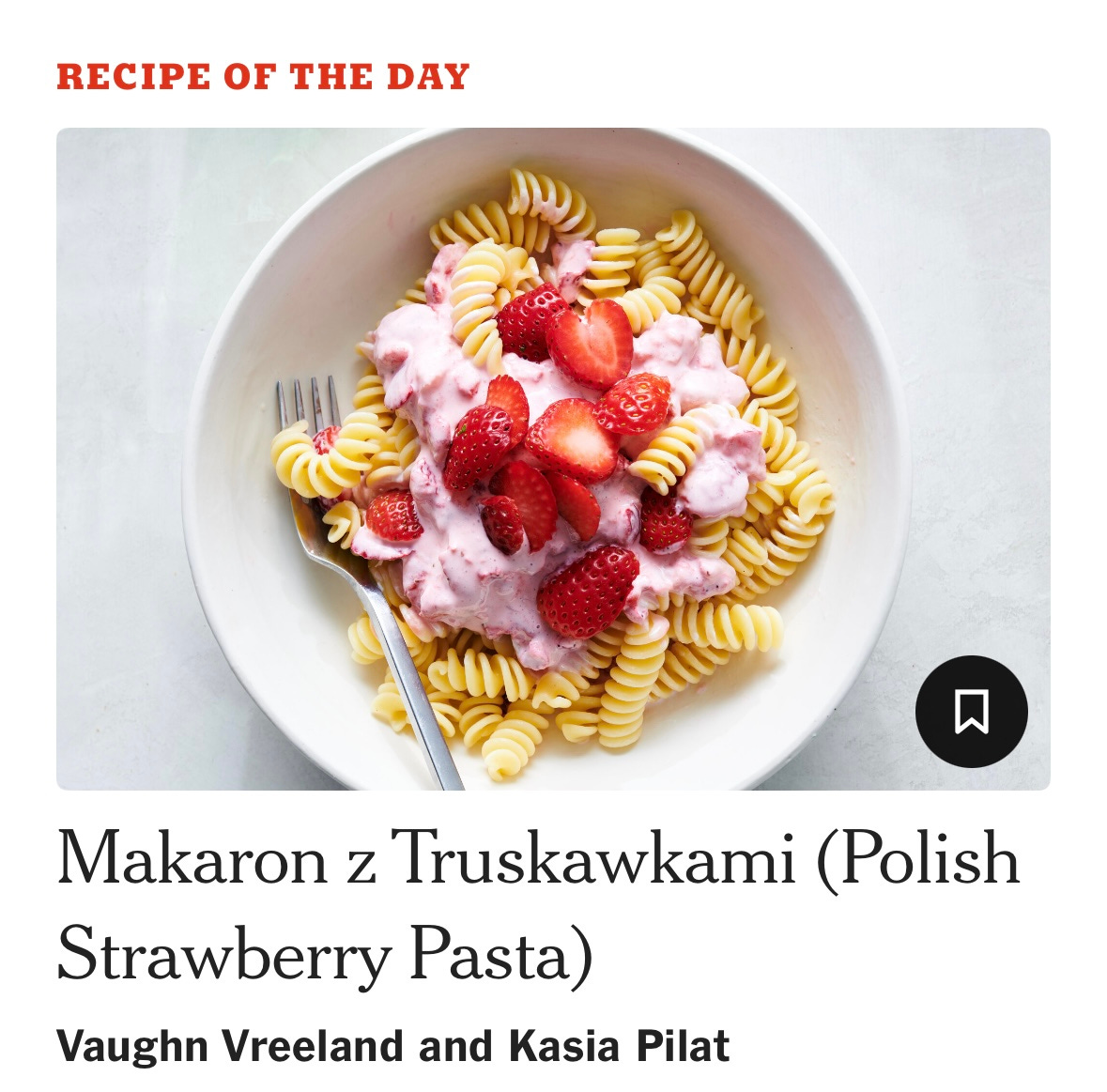
I am also not referring to the dish that seems to have all of Wimbledon talking this year: Makaron z Truskawkami, or pasta with strawberries 🍓 (pictured above). It’s apparently an old-fashioned dish from Poland that is a childhood favorite of Polish tennis star and newly crowned Wimbledon champion Iga Swiatek. She mentioned in an on-court interview a few days ago and set the tennis and food worlds abuzz. (Aside: I love when my two favorite worlds collide.) What is it, exactly? Cooked pasta dressed with a “sauce” of mashed fresh strawberries mixed with full-fat yogurt or sour cream and garnished with sliced fresh strawberries. The New York Times published a recipe and called it “surprisingly refreshing.” I have not tried it so I won’t weigh in.
What I’m talking about is what Italians call “pasta fredda” (cold pasta), or “pasta all’insalata” (pasta salad). But these are misnomers. Cold does not mean stone cold from the refrigerator, but rather a dish that has rested for awhile after being cooked, and is served either slightly warm or at room temperature. These are the sorts of dishes you might find at a snack bar at a beach lido (cabana), or a tavola calda, a casual eatery that serves dishes that are prepared in advance and set out on tables and in display cases. There used to be more such places in Italy than there are these days. (For a few years we had a really good tavola calda in Penne called Nonna Ersilia, but they closed last year and I deeply miss their eggplant parm and seafood salads.)
Pasta all’insalata is a more recent term, as far as I can tell. I don’t remember it all growing up. In any case, recipes for both pasta fredda and pasta all’insalata have become popular in recent years. Even mainstream publications like La Cucina Italiana have spotlighted them. Here’s a roundup of “cold” pastas from LCI’s website. Some look and sound fantastic, others like they are trying way too hard.
I started to rethink my own stance on pasta salad when I made the recipe for Pasta with Sun-Dried Tomatoes from Ina Garten’s book Barefoot Contessa Family Style. In the headnote she wrote that it was “always one of the most popular summer salads at Barefoot Contessa.” It’s robust in flavor, with Kalamata olives, Parmigiano cheese, lots of basil, and a dressing of sun-dried tomatoes and capers. I brought it to a pool picnic and it was a hit. For years, it was the only pasta salad I made. The second was also an Ina Garten recipe: Roasted Shrimp and Orzo. I’ve adapted it over the years, and I’ve shared the recipe below.
More recently, I’ve gone back to my own recipes to see which might successfully undergo “saldification” (a word I think I just made up?). Although there are no pasta salad recipes in The Glorious Pasta of Italy, there are several good candidates for adaptation. I chose two and went with them. One is Pasta Fredda alla Pecorara, based on a classic dish from the Teramo province of Abruzzo called Anellini alla Pecorara—handmade ring-shaped pasta dressed with ragù and brightened by the addition of colorful vegetables and a shower of fresh sheep’s milk ricotta. The other is BLT Pasta Salad with Caper Dressing, an adaptation of the recipe for BLT Bucatini in Glorious Pasta. Those recipes, linked below, are available to paid subscribers.
Tips for Making Pasta Salad
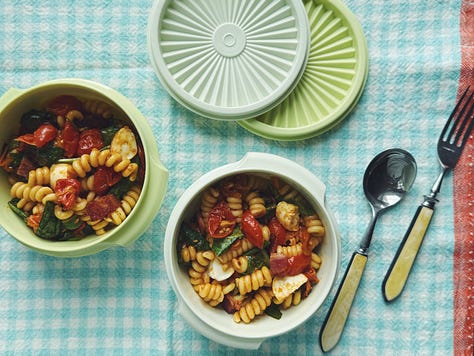

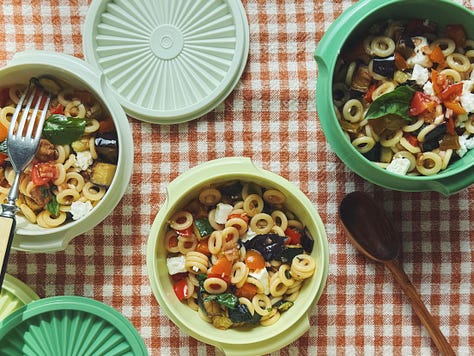
Following these suggestions will help you make successful pasta salad that isn’t overcooked or gloopy or otherwise unpleasant.
1. Use ingredients with vibrant flavors: anchovies, capers, olives, garlic, roasted or sundried tomatoes all shine in pasta salad. Although mild in flavor, ingredients such as eggplant and zucchini also work, as they absorb dressing and the flavors of ingredients around them.
2. Be generous with herbs. Basil, mint, oregano, thyme. They all add lots of flavor and color to pasta salad. However, their color can muddy over time. Fold some in when you assemble your pasta salad, then toss in another handful at serving time to refresh the color and flavor.
3. Adding cheese. Both fresh and aged cheeses go well in pasta salad. I’ve found adding both to a pasta salad adds texture and lots of flavor. Fresh mozzarella, ricotta salata, and feta are all good fresh cheeses to toss into a pasta salad. Freshly grated Parmigiano Reggiano and pecorino are my go-two hard cheeses, along with aged Asiago. I usually wait until serving time to fold in the cheeses; adding them too early can weigh down the pasta as it sits.
4. Seafood and meat. Grilled or broiled shrimp and cooked or smoked salmon are good candidates for pasta salad, as is tinned fish (anchovies, sardines, tuna). I tend not to use meat in pasta salad because it can be heavy. But I love the sprinkling of bacon in the BLT pasta salad. In that case, I cook the bacon in advance but don’t add it to the salad until right before serving. To get rid of any congealed fat, I just zap the bacon in the microwave to warm it up a bit. Be sure to use fairly lean bacon and cook it until it’s crispy. If you add seafood or meat to a salad more than an hour or so in advance, let it rest in the refrigerator rather than at room temperature to avoid potential spoilage.
5. EVOO. A few glugs of olive oil, either on its own or as part of a dressing/vinaigrette, will keep noodles from sticking together. The oil should be good quality, but not “fresh” (recently harvested/bottled) oil, which could overpower the dish.
6. Vinegar and other acids. I don’t typically use acids in pasta, unless I’m making something like spaghetti al limone. But I love them, especially vinegar, in pasta salad. Don’t waste very expensive DOP balsamic on a pasta salad; use good wine vinegar or cider vinegar, and maybe a splash of decent but not bank-breaking balsamic vinegar. My go-to is the white balsamic vinegar from Acetaia Cattani.
7. Choosing pasta. My personal preference for Italian-style pasta salad is a short shape such as fusilli, penne, or medium shells; or small shapes like anellini (little rings) and orzo. Short shapes make an eye-catching presentation; plus they are easy to serve and easy to spear with a plastic fork if you happen to be serving the salad at a picnic.
8. Cooking the pasta. This should be done in plenty of salted boiling water so that the starches remain diluted. Stop the cooking process before the pasta reaches the al dente stage. It will continue to soften once it has been tossed with a dressing and other ingredients.
9. To rinse or not to rinse? Many pasta salad recipes call for rinsing the noodles briefly in cold water to stop the cooking process. I skip this step, as it seems to drain away flavor. Instead, I make sure to dress the hot cooked pasta immediately with a little dressing, or even plain olive oil to give the noodles a slippery coating that prevents them from sticking together.
10. The rest. Pasta salads benefit from a room-temperature rest. After tossing cooked noodles with dressing, I let them sit for about 15 minutes on their own before adding anything else. Then I fold in other components, usually cooked or, occasionally, raw vegetables and herbs, olives, and the like. If I know I’m serving the salad within an hour or two, I may add in cheese, shrimp or other seafood, or meat. Otherwise, I leave those ingredients out until serving time. Taste a forkful of your pasta salad right before serving and make any necessary adjustments, such as adding salt and pepper, a splash of oil or vinegar, or a spritz of lemon juice.
A final important detail: For me, pasta salad has to be at least as appetizing as a good, standard plate of pasta; say, spaghetti al pomodoro or spaghetti alle vongole. During my pasta salad experiments, I tried to “saladize” the recipe for Rigatoni with Green Olive-Almond Pesto and Asiago Cheese from The Glorious Pasta of Italy, adding bottled artichokes to the mix among other changes. It was good, but not as good as the original version, so it did not make the cut.
RECIPE: Shrimp and Whole-Wheat Orzo Salad
This is one of the recipes that changed my mind about pasta salad. I bought a box of Wegman’s whole-wheat orzo a few years ago on a whim. It was summer, so orzo salad came to mind, even though I’d never made one. A google search turned up this recipe from Ina Garten, which pairs the plump little slivers of pasta with broiled shrimp in a lemon vinaigrette. I like Ina’s recipes; they’re uncomplicated, indulgent, and they work. I used her recipe as my starting point and made a few changes, scaling down the amount of orzo and dressing while adding more supporting ingredients—cherry tomatoes, olives, bite-size “ciliegine” mozzarella balls, and some leftover grilled zucchini. The orzo, slippery as melon seeds, happily soak up the lemon dressing and the flavors from the shrimp and vegetables. In other words, the salad is good. Now I buy whole-wheat orzo with intention.
As with all pasta “salads,” serve this at room temperature rather than cold. Cold orzo clumps together and is not pleasant to eat. The salad can be made ahead of time and refrigerated but bring it back to room temperature before serving.
INGREDIENTS
8 ounces (227 g) whole-wheat orzo
1/3 cup freshly squeezed lemon juice (from 1 large or 2 small lemons)
1/3 cup extra-virgin olive oil, plus more as needed
1 teaspoon fine sea salt, or to taste
Freshly ground black pepper
1 pound (455 g) medium shrimp, peeled (except for the tails) and deveined
Pinch of crushed red pepper flakes
6 baby zucchini (or 3 medium), halved lengthwise
12 “ciliegine” (cherry-size) mozzarella balls
1/2 pint cherry tomatoes, cut in half
1 small red onion, cut into small dice
1 medium cucumber, peeled, seeded, and cut into bite-sized pieces
2/3 cup (100 g) Kalamata olives, pitted and halved
1/2 cup (100 g) good Greek feta, crumbled into large chunks
Handful of chopped fresh herbs, such as basil, marjoram, mint, oregano, and dill; plus some sprigs for garnish
INSTRUCTIONS
1. Preheat the oven. Set it to broil and arrange a rack in the top third, about 4 inches from the heating element.
2. Cook the orzo. Fill a medium pot with water. Bring to a boil and salt it generously. Pour in the orzo and stir to prevent it from clumping. Boil for 8 to 9 minutes, until al dente. Drain and pour into a large bowl. Whisk together the lemon juice, olive oil, 1 teaspoon salt, and a few grindings of pepper. Pour all but a few tablespoons over the hot orzo and stir well.
3. Broil the shrimp. Place them on a sheet pan; drizzle with a couple of tablespoons of olive oil and season lightly with salt and crushed red pepper. Toss to combine and spread out in a single layer. Broil for 3 to 4 minutes, until cooked through. Don’t overcook or you’ll end up with tough shrimp. Remove from the oven but leave the broiler on.
4. Broil the zucchini. Arrange the halves, cut side up, on a baking sheet. Brush with a little olive oil and season lightly with salt and pepper. Broil for 4 to 5 minutes, until browned and just tender. (If you’re using larger zucchini, cut them into 2-inch pieces after broiling.)
5. Assemble and serve the salad. Add the shrimp and zucchini to the orzo, along with the mozzarella, cherry tomatoes, onion, cucumber, olives, feta, and chopped herbs. Drizzle on the reserved dressing and gently fold everything together. Set aside at room temperature for an hour to give the flavors a chance to mingle. Or, to serve cold, refrigerate for a couple of hours or overnight. Garnish with herb sprigs and serve.
Click on the button below for a printable version of the recipe, available to paid subscribers.
RECIPE: BLT Pasta Salad with Caper Dressing
There’s a recipe for BLT Bucatini in The Glorious Pasta of Italy. In it, pancetta stands in for American-style bacon, arugula for lettuce, and slow-roasted cherry tomatoes for the sliced fresh tomatoes that are the foundation for the classic diner sandwich. The bucatini (fat noodles pierced through their center with a hole) take the place of bread. It’s a recipe I’m proud of, as it was unusual—especially back in 2011 when the book was published. And it makes a great summer dish.
I’ve now reworked it into this pasta fredda version, and it’s possible I like it even better this way. I substituted fusilli corti bucati (short spirals that, like bucatini, are pierced through with a hole) and added a tomato-caper dressing. I also decided to use uncured smoked bacon rather than pancetta, for that classic BLT flavor.
Click on the button below for the full, printable recipe, available to paid subscribers.
RECIPE: Pasta Fredda alla Pecorara
In 2009, when I was researching The Glorious Pasta of Italy, I learned of Anellini alla Pecorara, from Abruzzo’s Teramo province. Hand-shaped pasta rings made with egg-rich dough are dressed in tomato sauce (or Abruzzese ragù) enriched with cubes of eggplant, peppers, and zucchini. The crowning touch is a shower of pure white sheep’s milk ricotta on top.
I had a notion that Pecorara would be a good candidate for “saladifcation.” It was.
Click on the button below for the full, printable recipe, available to paid subscribers.
Thank you for reading, subscribing, and sharing. To keep up with what I’m cooking during the week, follow me on Instagram.
Alla prossima,
Domenica

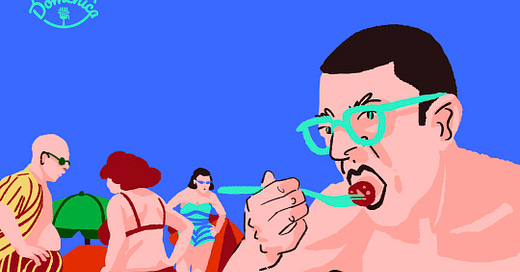



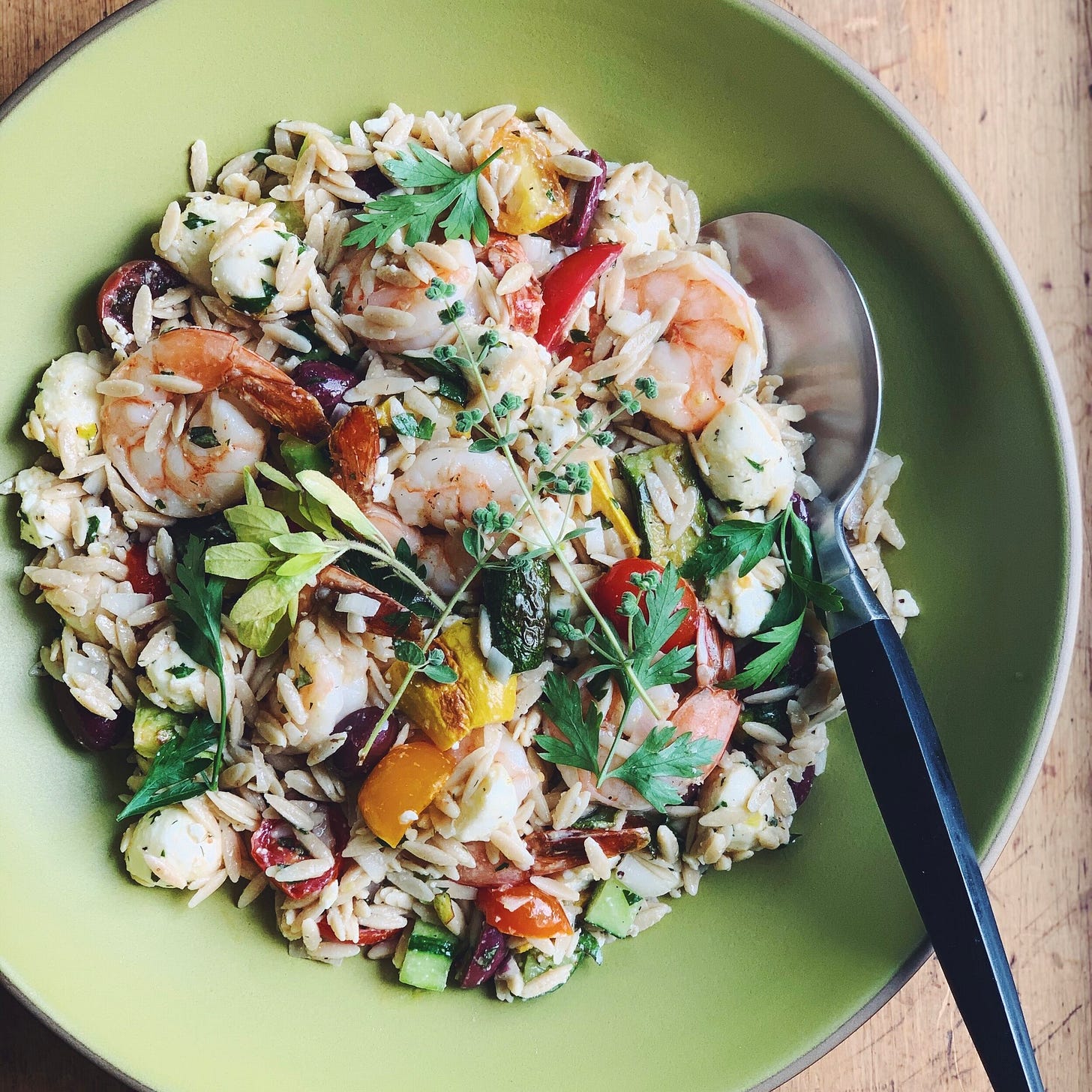
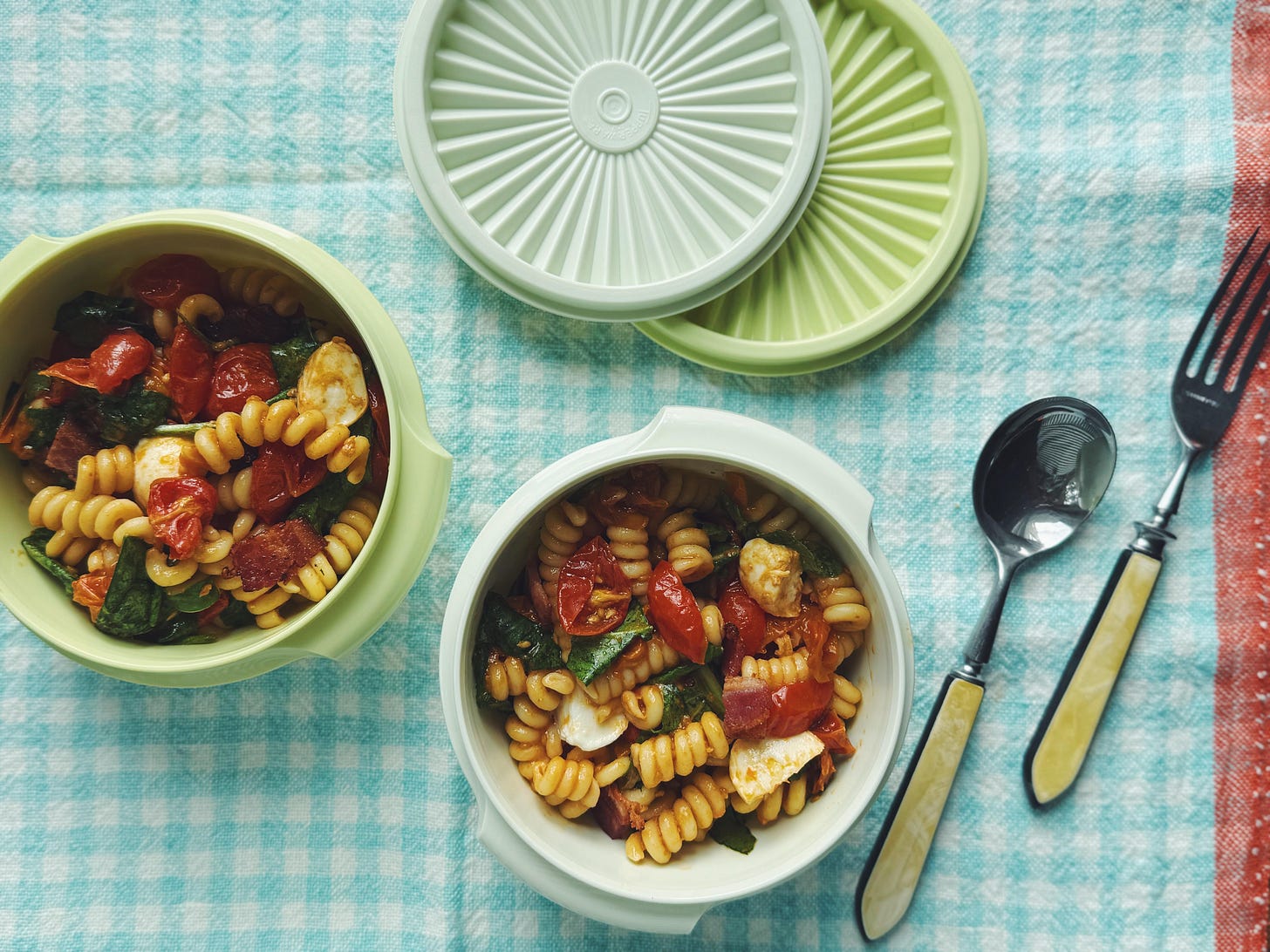
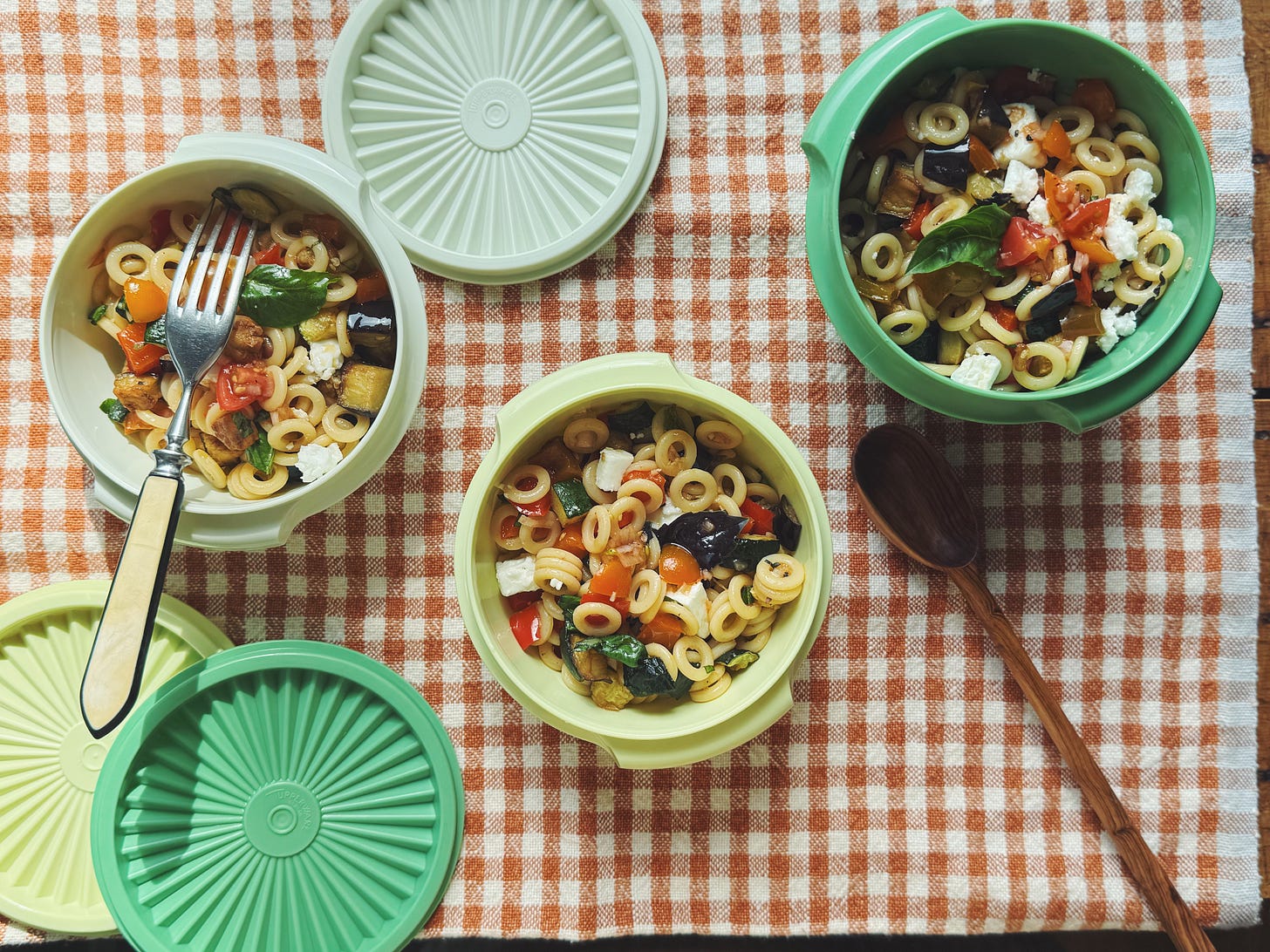
These all sound so good! I make BLT salad with croutons that I toast in the bacon/guanciale/pancetta grease, but I am going add a pasta version to my repertoire.
Hi. Thanks for the fun recipes. Here’s one more, although I don’t know whether I would call it a ‘salad’ or not. It’s a modification of one I got from Anna Maria Callen’s book ‘Food and Memories of Abruzzo’. It involves olive oil, a bit of chopped garlic, chopped fresh tomato, chopped Sun-dried tomato, capers and pine nuts mixed in a serving bowl. Add cooked spaghetti and a bit of water to toss. Once the pasta has cooled a little bit, add shredded basil leaves and toss again. The goal is to not completely wilt the basil. This was my children’s favorite summer pasta. Hope you like it.
Your occasional neighbor in Penne, Neal.